What is Price Elasticity?
Pricing Elasticity is at the core of pricing science. A good price elasticity measures the change in quantity demanded for a given change in price.
An elasticity of -1.25 means that for every 1% increase in price, the quantity demanded decreases by 1.25%. Elasticity is typically negative since the higher the price, the lower the quantity demanded. It is usually spoken of in absolute terms, and therefore the remainder of the article will refer to elasticity in absolute terms.
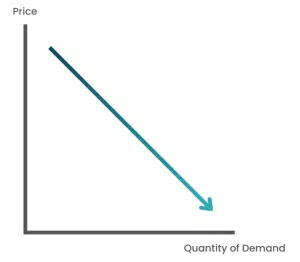
Every point on this demand curve represents a group of people (segment) that are willing to pay that price. Near the top of the elasticity curve is the segment that only shops direct and won’t shop around. They go directly to www.samsung.com and buy from there. Further down the curve, there are more segments to capture, but they’re more sensitive to price and have a lower willingness to pay.
Price Elasticity Explained
A good that has an elasticity with an absolute value greater than 1 is said to be elastic. A good that has an elasticity of 1 is unitary elastic, and a good with an elasticity with an absolute value below 1 is said to be inelastic. Elasticity is a spectrum, so the greater the absolute elasticity the more elastic a good is. Higher elasticity means that a price change will have a higher proportional impact on quantity demanded.

Elastic and inelastic products can be found within the same categories. For retail fashion, a Gucci handbag is relatively price inelastic, while unbranded or generic handbags available on platforms like Amazon are relatively elastic. A Gucci handbag is a branded product, sold by one company, and desired by luxury fashion consumers.
All these factors make it less elastic, so a 15% change in price won’t shift demand significantly. However, a personal Dell laptop has a lot of similar alternatives (HP, Acer, Asos, Lenovo, etc.) that customers can substitute. A 15% change will shift demand more significantly.
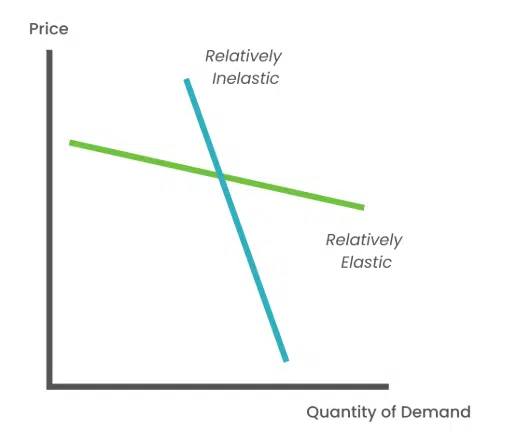
Differences in elasticity can be noted within the same product range as well. The premium mobile phone industry has a small group of superior, inelastic products and a range of elastic ones. The latest iPhone is less elastic than an older version. There are customers across the demand curve for each of these phones. The customer that wants the latest iPhone has a higher willingness to pay than one looking for a temporary replacement for their recently lost Nokia.
In the grocery industry, essential products with limited substitutes like eggs are relatively inelastic while nonessential products such as liquor are relatively elastic. To explore practical examples further, the image below illustrates a range of products and services and their positions along the elasticity curve.
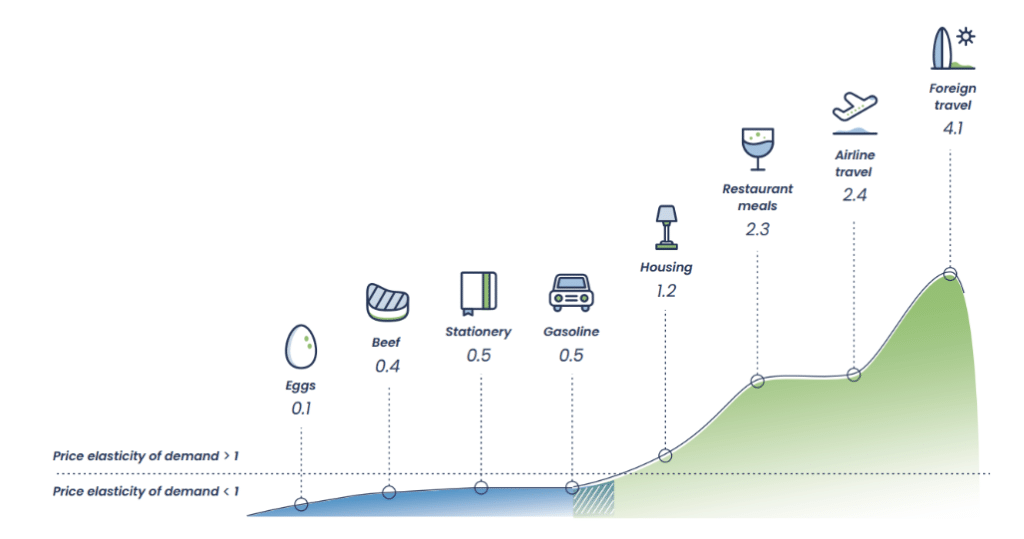
How Do You Calculate Price Elasticity?
There are two main ways to calculate elasticity. Point elasticity measures the change in quantity demanded for a change in price at a specific point on the demand curve. It depends heavily on which two points on the curve are chosen as starting and end points of the calculation. Point elasticity is most accurate for small price changes and changes along the demand curve.
Conversely, arc elasticity, also known as the mid-point method, is calculated by taking the average of the starting and ending points of prices and quantities. It gives the average elasticity of a section of the curve, or between two points.
Point Elasticity
Point elasticity is calculated by dividing the change in quantity demanded by the change in price between two points on a curve.

Arc Elasticity
Arc elasticity is calculated by measuring the elasticity at the midpoint between two points on the curve.

What are Elasticity-Related Pricing Strategies?
The goal of an elasticity related pricing strategy is to find the profit-maximizing curve.
There are three curves to consider. The already familiar 1) price to quantity curve must be combined with 2) the price to revenue curve and 3) the price to profit curve.
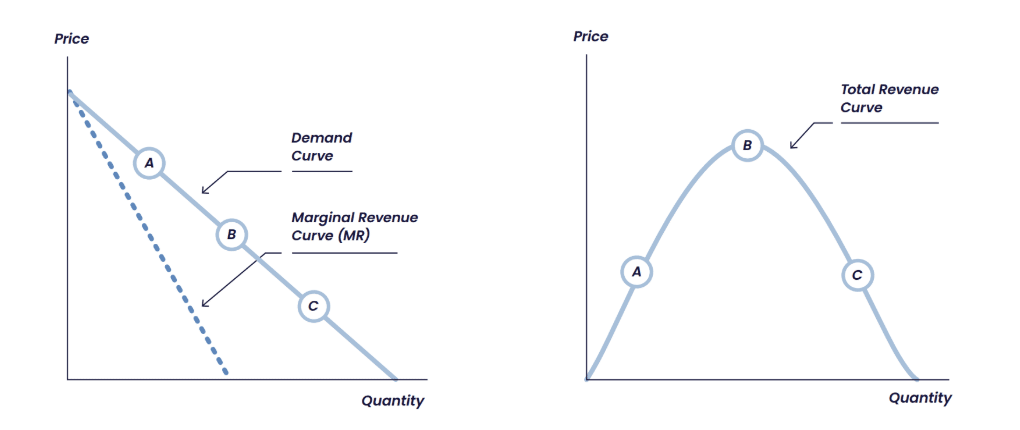
The marginal revenue curve (MR) shows the increase in revenue from selling one additional unit. In this example, the demand curve is linear and revenue is maximized at point B. However, neither of these two curves account for cost. Like marginal revenue, marginal cost (MC) shows the cost impact of selling one additional unit. Therefore, profit is maximized when MC = MR.
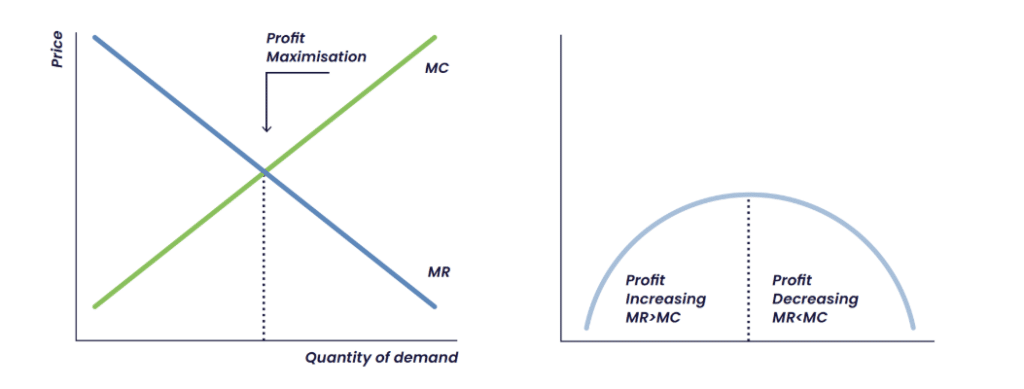
The price to quantity is a decreasing curve. Price to revenue is an increasing curve or semicircle. In retail, there is a low range of pricing where units are sold. The price to profit curve is a semicircle, in which the goal is to find the top of the curve.
At either end of the pricing extreme – pricing at zero or at infinity – profit is null. When priced at zero, no matter how many units are sold, profit will be zero. At a very high price, the per unit profit will be very high, but there is unlikely to be enough units sold to make a profit.
How Does Price Elasticity Look in Practice?
There are two implementation approaches for elasticity related pricing strategies. One is an optimization approach in which prices are changed by X% to a potential profit maximizing point and then re-calculated and re-tested based on the real quantity impact.
Another way, used when a complete elasticity curve is not available, is to change price based on the elasticity of individual products. This approach is often used by supermarkets. To increase revenue, decrease the price of very elastic goods such as pots and pans. To increase profit, increase the price of inelastic goods like bread.
Overall, the goal is to maximize profit, not to calculate the elasticity number. While these strategies are useful, they do not cover the full picture.
What Makes Price Elasticity Challenging in Retail?
In most retail cases, the demand curve isn’t linear, so one elasticity number is just a piece of the puzzle.
With different curves, a single number cannot be used to say anything about elasticity. Even arc elasticity assumes that the arc is linear, so more points along the curve are needed. Additionally, some points on the curve are not relevant due to inventory and replenishment constraints.
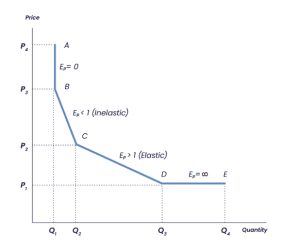
Sparse Data
Very often, pricing data at a product level is sparse. In this case and when there are many products, elasticity can be calculated by clustering similar products into groups. This means that not every product needs to have pricing history to calculate elasticity.
Recalculating Elasticity
Elasticity is not a static measurement. It must be recalculated regularly. The price elasticity of the latest iPhone now will be different than in two years. Competitive changes constantly influence the demand curve.
Elasticity in the Online World
Selling online presents additional challenges for calculating elasticity. While quantity is straightforward for brick-and-mortar businesses, online platforms can always buy more traffic or users, thereby influencing quantity. More money can be spent on marketing to get a higher quantity instead of decreasing the price. This undue influence on quantity means that the price elasticity theory is broken in the online world.
The online world impacts price elasticity in other ways, too, as consumer purchasing behavior becomes impacted by growing consumer exposure to historical pricing data. A Harvard Business Review Study shows how price changes influence consumers’ buying decisions, based on historical increases or decreases in price, in addition to the frequency of these historical price shifts.
Coefficients: What Other Factors Impact Elasticity?
Elasticity isn’t just about price and demand – it’s also influenced by external factors known as coefficients (or covariates).
These factors provide a broader context by incorporating external influences, such as seasonality, competitor actions, and market conditions, into the demand curve. By accounting for these influences, businesses can better understand the nuanced interplay between pricing decisions and consumer behavior.
For instance, sudden shifts in market conditions may dramatically alter purchasing habits, while seasonal trends introduce predictable but impactful variations to demand patterns. Competitor actions, such as abrupt price drops or strategic promotions, further complicate the landscape. These coefficients make the demand curve not only more precise and actionable but also dynamic and reflective of real-world complexities.
Seasonality
Seasonal trends significantly affect price elasticity and manifest across various contexts:
- Holiday Seasons: During high-demand periods, price sensitivity often increases as customers seek discounts or gifts. Even a small price reduction can trigger disproportionately higher sales volumes, particularly seasonal items.
- Day-of-Week Effects: Grocery shopping habits exhibit clear patterns – weekdays might see higher demand from busy professionals grabbing essentials, while weekends attract families shopping in bulk.
- Time-of-Day Patterns: Afternoon shoppers differ in behavior from evening buyers, especially for time-sensitive products were urgency drives purchasing decisions.
Beyond these examples, seasonality can encompass broader trends such as annual cycles in industries like fashion or agriculture, and even micro-level fluctuations within specific timeframes. Incorporating seasonality into elasticity calculations enables businesses to align their pricing strategies with short-term and long-term consumer behaviors, ensuring precision, relevance, and impact in pricing decisions.
Cross Elasticity
The interplay between related products often reveals surprising shifts in demand:
- Complements: Products like eBooks and eBook readers (e.g. Kindles) show a negative cross elasticity. A price drop in eBook readers directly boosts eBook sales by increasing accessibility and affordability.
- Substitutes: Competing shampoo brands demonstrate positive cross elasticity. A price increase in Shampoo A encourages consumers to switch to Shampoo B, especially in markets with abundant alternatives.

Cross elasticity extends beyond simple pairings to influence entire product ecosystems. For instance, lowering the price of printers might significantly increase sales of complementary ink cartridges, even if their prices remain unchanged. However, pricing adjustments within a product portfolio can also lead to cannibalization, where increased sales of one product reduces the demand for another, potentially impacting overall profitability. In competitive industries like electronics or automotive, understanding how pricing for one product impacts others within a portfolio is critical for optimizing overall profitability.
Understanding cross elasticity enables businesses to predict and capitalize on the interconnected influences between related products, creating opportunities for strategic bundling, promotions, or targeted discounts.
Psychological Price Points
While elasticity quantifies the relationship between price and demand, consumer psychology introduces additional layers of complexity to pricing decisions. Psychological price points refer to specific price thresholds at which consumer perception of value shifts significantly. These price points serve as mental benchmarks that influence purchasing behavior. For example, a consumer might perceive a scarf priced at $99 as significantly cheaper than one priced at $100, even though the actual difference is minimal.
When these price points are crossed, the elasticity of demand can experience sudden and noticeable jumps. Psychological price points are important to consider alongside price elasticity of demand. Here are a few reasons why:
- Consumer Perception of Value: Prices just below a round number (e.g. $9.99 instead of $10) can be perceived as better deals.
- Price Tiers and Affordability: Crossing into a higher tier (e.g. moving from $49.99 to $50) can push a product into a category that feels less affordable, reducing demand.
- Anchoring and Expectations: Consumers often anchor their perception of fair pricing based on previous purchases or market norms. Deviations from these anchors can disproportionately affect demand.
By integrating psychological price points into elasticity models, businesses gain sharper insights into product behavior, enabling pricing strategies that enhance consumer appeal and profitability.
Competitor Price Sensitivity
Market competition dynamically shapes how customers respond to pricing changes:
- Price Wars: Aggressive price reductions by competitors can force mid-range brands to adapt quickly to maintain market share, especially in saturated markets where alternatives are abundant.
- Omni-Channel Pricing: Offering the same product at varying prices across different platforms (e.g., Amazon vs. a direct-to-consumer website) captures diverse customer segments along the demand curve, catering to differences in willingness to pay.
Competitor price sensitivity is further influenced by brand perception and positioning. Premium brands may retain higher prices due to strong loyalty or unique features, while mid-tier brands face greater pressure to match competitor discounts. Competitor dynamics underscore the necessity of real-time pricing strategies, allowing businesses to proactively respond to market changes while safeguarding their competitive edge.
At Quicklizard, our competitive intelligence tools can help businesses balance competitive pressures with profitability, enabling data-driven decisions that resonate with their target market.
Why Do Coefficients Matter?
Differentiating between types of shifts is critical:
- Consumer-Driven Movements: These are natural changes along the demand curve due to price adjustments, reflecting immediate consumer responses.
- External Shifts: These involve broader movements or shifts of the entire demand curve, driven by factors like market trends, seasonal variations, or competitive pressures.
Properly accounting for coefficients ensures that businesses refine their understanding of price sensitivity and make more informed, strategic decisions. These distinctions help organizations avoid common pitfalls, such as overestimating the impact of internal pricing changes while ignoring broader market forces.
By integrating coefficients into elasticity models, businesses gain a holistic view that enhances decision-making across pricing and demand planning. This comprehensive approach empowers them to remain agile, competitive, and well-prepared to navigate complex market environments.
Case Study: Consumer Electronics
The first iPhone launched in 2007 for a starting price of $499. By 2021, the starting price of the latest model had risen to $799, with the Pro version at $999, showing a 60% increase for the flagship model within 14 years.
The iPhone is notoriously known as a price inelastic good. The brand power of Apple and amount of loyalty displayed by its customers seemed to have no bounds; customers would pay any price. However, Apple reached the point with their price increases where their elasticity curve broke, proving the curve is not linear.
In 2018, Apple released the iPhone XS, XS Max, and XR starting at $999, $1,099, and $749. The XS Max price went up to $1,449 for the version with the most memory, establishing it as the most expensive phone ever released by Apple. The previous years’ flagship model (iPhone X) had also debuted at $999, like its replacement (XS), but the replacement (XS) was now the mid-range offer, not the top. This was the tipping point.
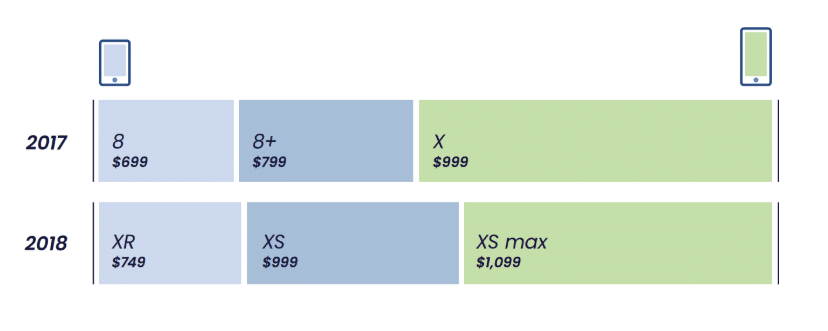
While the iPhone X made up 20.1% of its inaugural years’ sales, the iPhone XS made up just 8.5% by the same time the following year. That year, the cheaper XR model ($749) dominated with 39.5% of sales.
By 2021, the flagship model was back down to a starting price of $799 and the Pro version at $999 – both below the 2018 levels. The change in starting prices indicates that Apple reached a part of the curve where elasticity gave way. The assumption that the price would remain inelastic indefinitely was broken once the $1000 threshold was crossed.
Read more here on dynamic pricing for consumer electronics.
Case Study: Grocery
Cottage cheese is a popular commodity in Israel, where the Tnuva cooperative controlled up to 70% of the dairy market. Due to this monopoly, prices were regulated by the Israel Anti-Trust Authority until 2008.
In 2008, these price controls over dairy products were removed. Research demonstrated that cottage cheese is an inelastic good, and that the price could be increased with seemingly no bounds. Within 3 years, the price of Tnuva cottage cheese increased by 66%, from 4.82 to 8 NIS.
While Tnuva cottage cheese obeys the logic of inelastic products – essential product, low competition, no close substitutes, and constitutes a small proportion of income, this price increase broke the inelasticity argument. Widespread protests and boycotts broke out in Israel over the unaffordability of food. The government became involved and re-imposed price controls, and lowered tariffs on competing foreign dairy products. Tnuva lowered the price to 5.90 NIS.
The results of the cottage cheese boycott were widespread. Demand for cottage cheese dropped by 30% during the boycotts, brand loyalty diminished, customers substituted between brands, and post-boycott prices were below the profit maximizing levels. There was a blind trust that the product would always live on the inelastic part of the curve, however reality differed; inelasticity has its bounds.
Quicklizard's Comprehensive Approach
At Quicklizard, price elasticity is the cornerstone of our dynamic pricing strategies.
By understanding consumer sensitivity to price changes, our pricing optimization software empowers businesses to optimize revenue and remain competitive in dynamic markets. Our advanced tools and methodologies leverage cutting-edge technologies to create adaptive pricing solutions tailored to diverse market conditions.
Key Components of Our Price Elasticity Approach
Dynamic Demand Models
Our elasticity models utilize multiple functional forms to capture and represent demand patterns with precision. This ensures that the selected model provides tailored, reliable insights specific to the unique characteristics of each product and its market. For example:
- Behavioral and Preference Models: These models delve into consumer preferences and account for non-linear demand patterns, offering profound insights into buyer behaviors.
- Dynamic Pricing Models: Designed for rapidly shifting demand scenarios, these models address varying price sensitivities across different levels, ensuring agility and relevance in pricing strategies.
Machine Learning Techniques
Quicklizard employs advanced methods, such as Gradient Boosting and causal inference techniques to:
- Isolate causal relationships between price and demand,
- Correct for confounding variables that might skew elasticity estimates, and
- Enhance prediction accuracy for reliable, dynamic pricing adjustments.
Comprehensive Data Integration
To account for diverse demand coefficients and covariates, our methodology integrates key data elements that influence consumer behavior and market trends:
- Seasonality Features: Monitoring cyclical and temporal changes in demand, from annual trends to daily purchasing patterns.
- Competitor Insights: Analyzing competitor pricing strategies and promotions to uncover cross-elasticity impacts and market positioning opportunities.
- Product Attributes: Incorporating detailed product characteristics, pricing history, and performance metrics for richer and more precise demand analyses.
Clustered Demand Analysis
Beyond SKU-level analysis, we perform “group” elasticity analysis, clustering products into segments sharing similar elasticity characteristics. This process is refined using our in-house segmentation techniques, which analyze products by microeconomic traits, consumer behaviors, and market events. Key segmentation types include:
- Key Value Indicators (KVIs): Products that shape consumer price perception, often requiring competitive pricing strategies to attract attention.
- Sales Drivers (SDs): High-relevance items with moderate price sensitivity, playing a pivotal role in revenue generation.
- Profit Generators (PGs): Low-sensitivity items, such as impulse purchases, optimized for maximizing profitability.
These segmentation insights enrich group elasticity clusters with deeper demand dynamics, enabling precise and impactful pricing strategies across diverse product catalogs.
Read more here on product segmentation and its role in retail.
Driving Results Through Innovation
By leveraging advanced analytics, machine learning, and generative AI, Quicklizard transforms pricing intelligence into a strategic advantage. Our comprehensive approach to price elasticity analysis equips businesses with the tools to make smarter, data-driven decisions.
Unlock the full potential of your pricing strategy through actionable insights that fuel revenue growth, optimize profitability, and secure a competitive edge in dynamic markets.
How Quicklizard Pricing Software Can Help
Price elasticity is a multi-faceted topic. Using historical data and one elasticity metric is not enough. Quicklizard can help.
The Quicklizard elasticity module uses data science to calculate how a price change affects demand, while accounting for factors like seasonality, cannibalization, clustering, and competitor price changes.
The proprietary algorithm and full suite of pricing optimization and enrichment modules advances pricing excellence, at scale. It enables retailers to automate pricing and move to a fully digitalised pricing infrastructure that is tailored to business goals. Powered by science, designed for success.
To learn how QuickLizard can help you achieve pricing excellence, speak to one of our pricing experts today.










